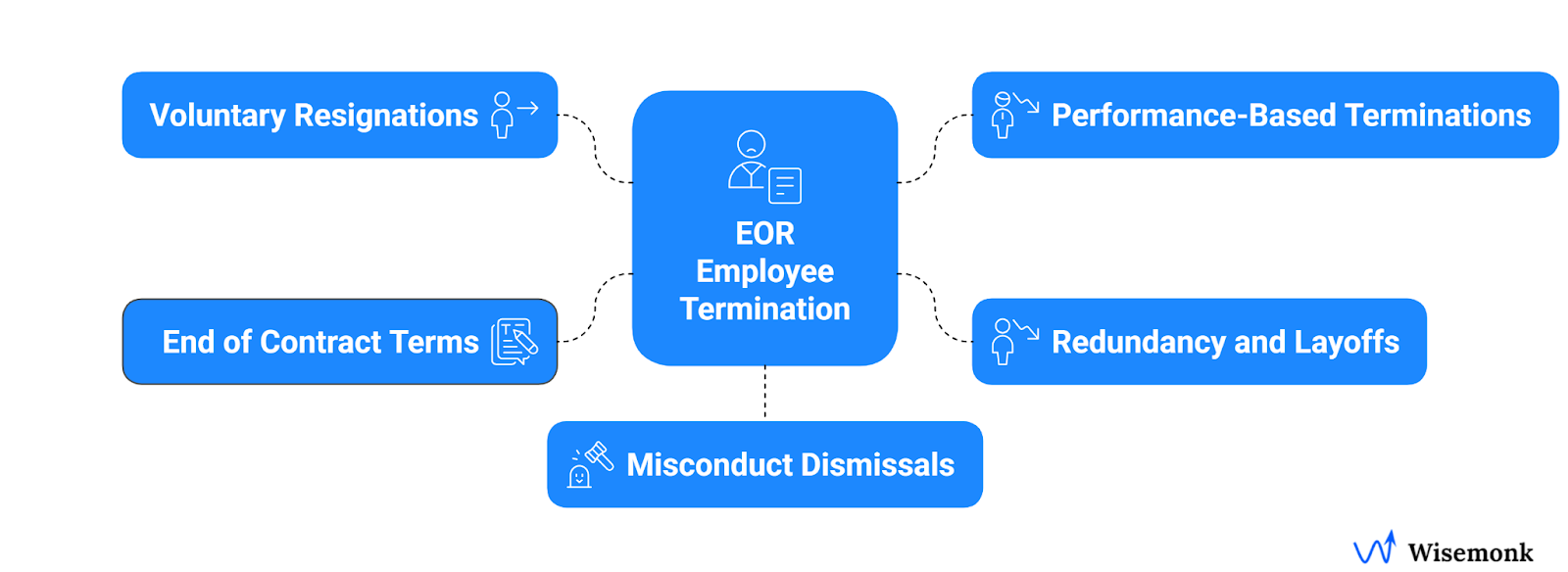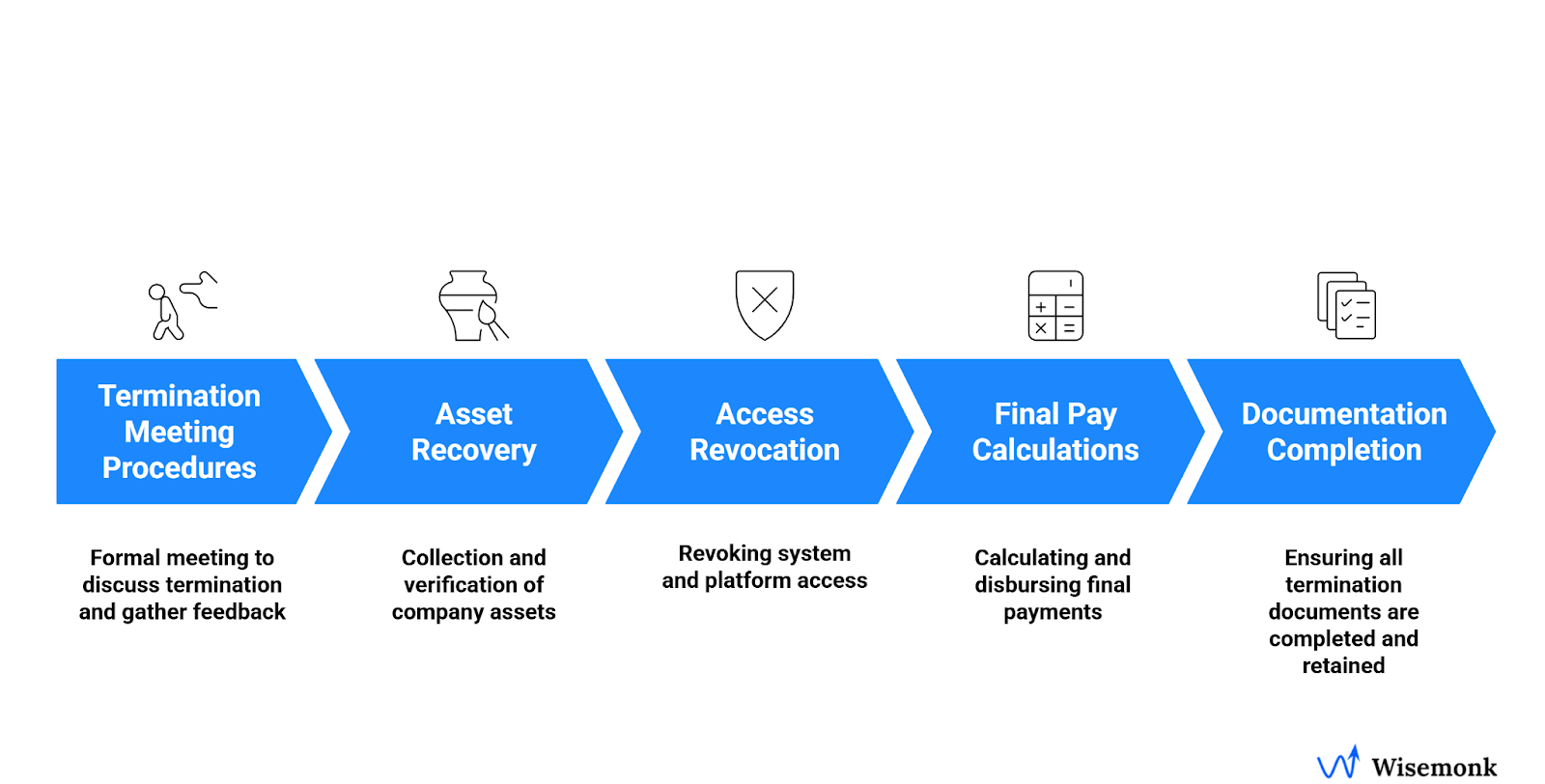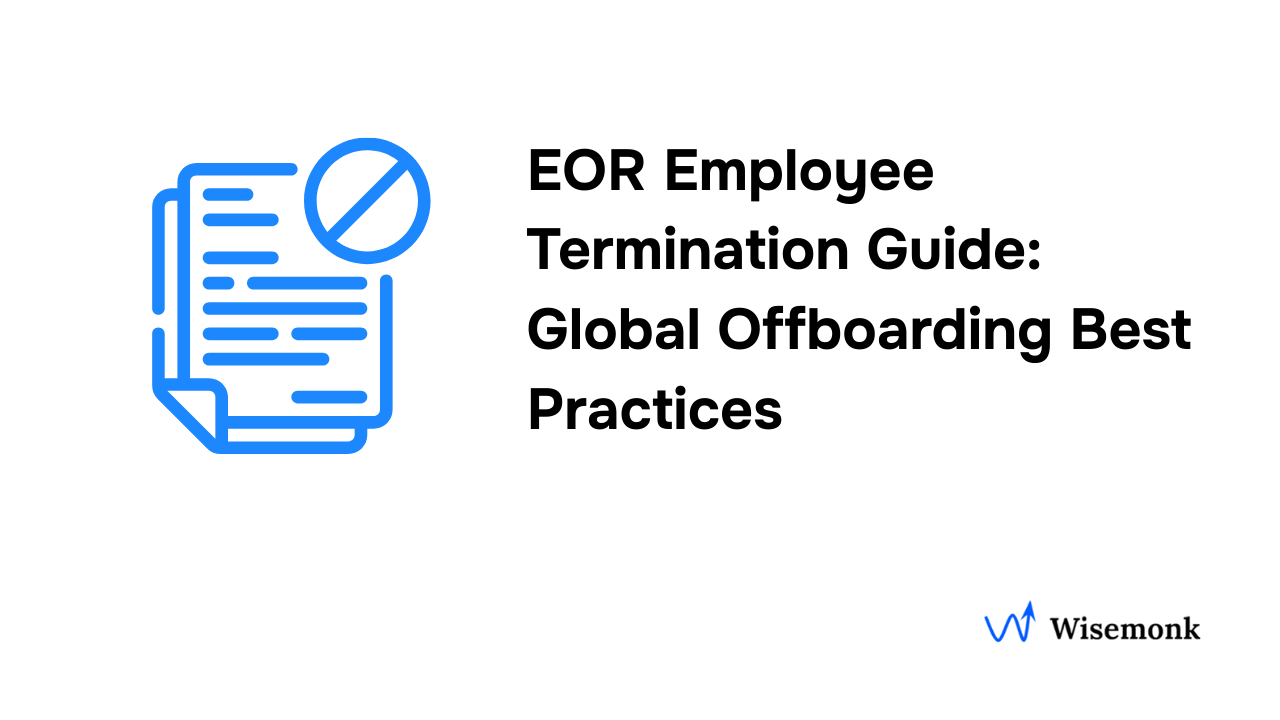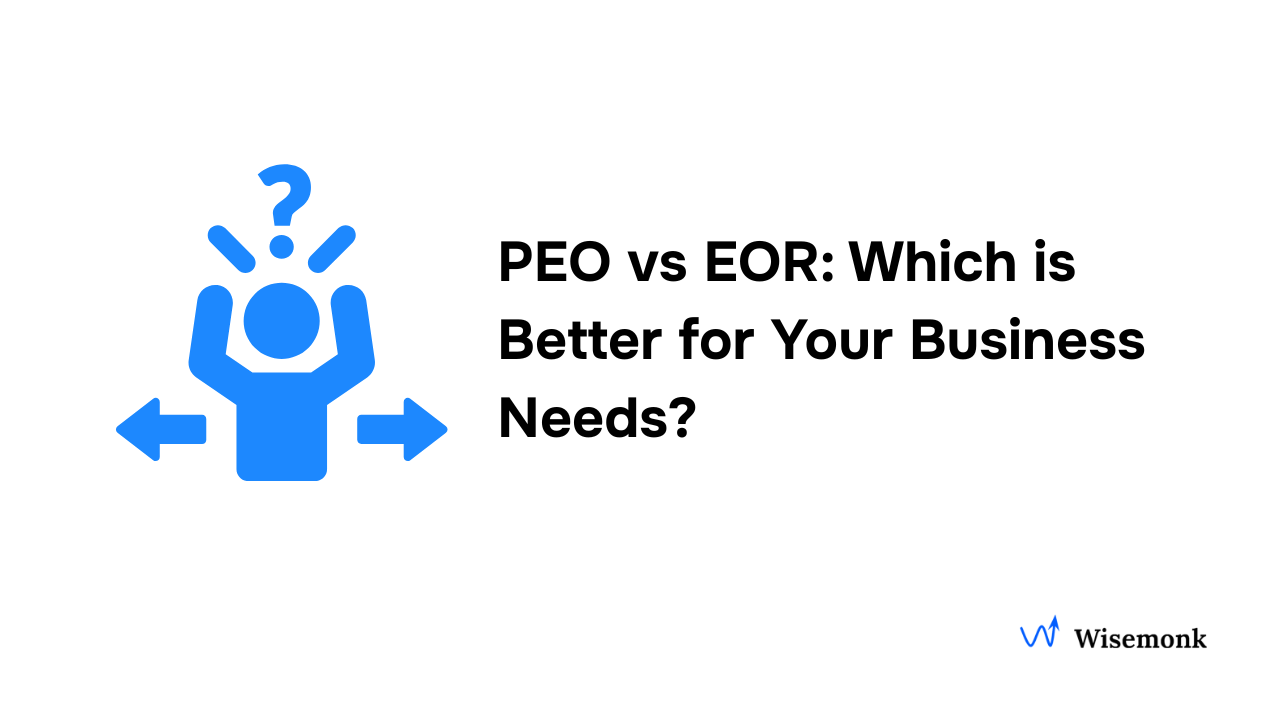How does EOR employee termination really work when your team spans multiple countries? Ending employment under an Employer of Record (EOR) isn’t just about the final paycheck. It means working through local labor laws, notice periods, severance rules, documentation, and data/access offboarding, each of which can look very different from one jurisdiction to the next. In our experience guiding global businesses, a single misstep, say, miscalculating severance in Europe or mishandling a sensitive exit in the U.S., can snowball into disputes, penalties, or operational slowdowns.
That’s exactly where the EOR earns its keep: as the legal employer, it standardizes the process, keeps you compliant, and ensures every exit is handled fairly and consistently. In this guide, we’ll break down EOR employee termination step-by-step, covering global notice and severance basics, required documentation, secure offboarding, and practical best practices, so you can manage departures confidently and protect your business wherever your people are.
What is EOR employee termination?[toc=What is Employee Termination]
EOR employee termination refers to the process of ending an employment contract when the worker is legally employed through an Employer of Record (EOR). Unlike direct employment, the EOR acts as the official employer, which means all termination steps, notice periods, severance, compliance checks, and final payroll must go through them. This ensures that the termination complies with local labor laws while protecting the client company from legal risk.
What are the types and reasons for EOR employee termination?[toc=Reasons for Employee Termination]
Ending employment under an Employer of Record (EOR) can happen for several reasons, and knowing these helps companies manage the process with legal compliance and minimal risk.

Voluntary resignations under an EOR setup:
Employees may leave voluntarily for personal growth, better job offers, or other reasons. Usually, a formal resignation letter and notice period, commonly 2 to 4 weeks depending on local labor laws, are required. The EOR then manages final pay, documentation, and asset recovery for a smooth exit.
Performance-based EOR terminations:
When an employee doesn’t meet expectations despite warnings and improvement plans, the EOR ensures fair, well-documented process compliance with termination procedures. This protects companies against wrongful dismissal claims by keeping clear records aligned with local regulations.
Redundancy and layoffs in global termination procedures:
Business changes often lead to layoffs or redundancies unrelated to employee performance. For example, in Germany, redundancy requires a social selection process considering age and tenure, while in the U.S., layoffs can be immediate but may require WARN Act notifications for large groups. The EOR handles all notice periods, severance payments, and mandatory consultations based on the relevant jurisdiction.
End of contract terms:
Fixed-term contracts naturally expire, and the EOR ensures all final payments and legal procedures comply with the employment contract and local entity rules.
Misconduct dismissals:
For serious violations like theft or harassment, immediate termination may be justified but must follow due process. The EOR conducts disciplinary hearings and documents everything to minimize legal risk.
Understanding these termination types helps both the employer and EOR navigate global termination procedures confidently with full compliance and minimal disputes.
What legal requirements apply to EOR employee termination in different regions?[toc=Legal Requirements]
Navigating global EOR employee termination means tracking a web of rules, and even a minor oversight can trigger legal claims, compliance risks, or payment disputes.
Notice Period Requirements:
Most countries require a formal notice period; for example, 30 days is common in India, and in much of Europe, notice periods range from 2 weeks to 6 months depending on tenure and jurisdiction. Some regions allow payment in lieu of notice, and misconduct dismissals can sometimes bypass notice completely. Always consult both the employment contract and local labor laws for clarity.
Severance Pay Obligations:
Severance payments vary by country, role, and circumstances. In India, retrenched employees are entitled to 15 days' pay per completed year of service. Across the EU and Latin America, severance calculation is based on length of service, unused leave, local regulations, and may include bonuses or benefits accrued. The EOR ensures all components, including stock options, healthcare continuation, and retirement funds, are handled legally and promptly.
Documentation Needs:
Detailed documentation is critical: a termination letter with clear reasons, a relieving letter, and evidence of legal compliance are standard. Records of meetings, final payments, and severance calculations must be retained. In every region, the EOR documents everything to protect both the employer and employee from future legal disputes.
Consultation Requirements :
Several countries, especially in Europe, require employers to consult employee representatives or unions before mass layoffs or redundancy. This ensures the termination process respects employee rights and supports a smooth, compliant transition. Failure to consult can result in heavy penalties.
Protected Employee Categories:
Employees may receive extra legal protection due to age, disability, pregnancy, union membership, or political activity. Terminating such cases demands additional documentation, legal consultation, and sometimes approval from government authorities. EORs closely monitor local regulations to ensure compliance with these sensitive categories.
Based on extensive research and experience guiding global companies, timely compliance and thorough documentation are the backbone of legally sound EOR employee terminations, no matter the region.
What steps are involved in the EOR offboarding process?[toc=Offboarding Process Steps]
Smooth EOR offboarding protects the company from disputes, ensures legal compliance, and creates a seamless transition for all parties involved.

1. Termination Meeting Procedures:
Never notify the employee until the EOR has reviewed and confirmed all details. The EOR leads the termination meeting, shares clear reasons for the decision, and discusses next steps, all in accordance with local labor laws and the employment agreement. This protects both the employer and employee from miscommunication and legal risks.
2. Asset Recovery:
The EOR coordinates the recovery of company property such as laptops, mobile devices, security cards, and any other resources. Every asset is logged and verified, minimizing risks and supporting security compliance.
3. Access Revocation:
System access, email accounts, databases, and internal platforms are promptly revoked following termination. Protecting sensitive business data is crucial; access is monitored and instantly revoked to ensure privacy and mitigate legal risks.
4. Final Pay Calculations:
The EOR handles complex final pay calculations, covering salary for days worked, unused leave, bonuses, severance payments, expense reimbursements, and deductions per local laws and employment contract. Full and final payments are made according to jurisdictional requirements.
5. Documentation Completion:
All necessary termination documentation, final settlement records, relieving letters, evidence of compliance, and any agreements, are accurately documented and retained for audits and legal claims. Comprehensive recordkeeping ensures compliance and smooth transitions.
EOR Offboarding: Quick Checklist
Based on our experience supporting global businesses, following these offboarding steps with an Employer of Record brings operational consistency, legal compliance, and a positive end to the employment relationship.
To learn more, refer to our article on Offboarding Process and Best Practices for HR in 2025.
What are the common challenges in EOR employee termination?[toc=Challenges]
When ending an employee relationship through an Employer of Record (EOR), companies face unique global hurdles involving legal compliance, company culture, and operational efficiency.
Wrongful Dismissal Claims
Legal risks are front and center during international employee termination. For example, most EU countries enforce very strict procedures and may require cause, advanced notice, and even consultation with employee representatives before termination. In the U.S., “at-will” employment means companies can usually end employment without cause, but anti-discrimination and contractual rules still apply. Failing to follow the employment contract, local labor laws, or proper notice periods can mean costly legal claims, government penalties, or forced reinstatement.
Cultural Sensitivities
Company culture and localized expectations impact every EOR offboarding process. In Asia, discreet, private exits are viewed as respectful and essential for preserving dignity, while in the U.S., a more open, transparent approach is common. Not understanding these cultural nuances can harm relationships, create misunderstandings, or damage the company’s employer brand.
Remote Employee Logistics
With global teams, logistics become complex, especially for remote international employees. Examples include arranging secure shipping of laptops and company devices across borders or dealing with delayed returns due to customs. Immediate access revocation from all systems is critical to protect data, but time zones and remote locations can slow this step. Coordinating these details efficiently is essential for both compliance and security.
Data Security Concerns
Failing to promptly disable system access or recover all assets can lead to IP leaks, data breaches, or reputational damage. EORs use automated access controls, structured offboarding checklists, and asset tracking to minimize such risks.
Provision of References
Issuing accurate, non-biased references is critical. In some jurisdictions, refusal or mishandling of employment references can trigger legal claims or harm an employee’s future prospects. EORs help create standardized, compliant reference letters to protect against disputes and ensure fairness.
In our experience guiding global businesses, proactively addressing regulatory, cultural, and security challenges is what sets apart successful EOR terminations, ensuring legal compliance and smooth offboarding, no matter the country.
If termination challenges with your current provider are becoming frequent, it may be time to explore better EOR alternatives like Deel vs Remote, to ensure smoother compliance and offboarding experiences.
What are the best practices for global EOR employee termination?[toc=Best Practices]
Handling EOR terminations professionally helps minimize legal risks and ensures smooth, compliant transitions. Successful termination centers on the three C’s: Compliance, Communication, and Consistency.
- Maintain Clear Documentation:
Accurately record performance issues, termination decisions, notices, and severance details. Well-kept termination documentation protects all parties from potential legal claims and supports compliance with local labor laws. Legal consultation with HR or law professionals reduces risk and prevents disputes. - Seek Legal Consultation:
Before finalizing any termination, verify compliance with relevant jurisdiction laws and employment agreements. Consulting legal experts helps navigate complex termination procedures and reduces the risk of disputes. - Communicate Openly and Respectfully:
Conduct termination meetings with clear, empathetic communication to maintain company culture and reduce misunderstandings. Transparent offboarding processes promote positive employer-employee relations. - Implement Consistent Processes:
Following standardized steps, from notice to final pay, across EOR arrangements ensures fairness and regulatory compliance. Consistency helps minimize operational disruptions and build trust in global teams.
Based on our extensive experience as a leading Employer of Record, these best practices form the foundation for risk-free EOR employee terminations and seamless transitions. Working with experienced EOR partners like Wisemonk ensures expert guidance, deep local knowledge, and proactive support, helping you navigate terminations confidently and compliantly worldwide.
Conclusion[toc=Conclusion]
Managing EOR employee termination requires a clear understanding of complex local labor laws, transparent communication, and strict adherence to all legal requirements. By following proper termination procedures, documenting every step meticulously, and working hand-in-hand with the Employer of Record (EOR), companies can minimize legal risks, prevent disputes, and ensure a seamless end to the employment relationship.
Wisemonk is a leading EOR service provider specializing in:
- Comprehensive global compliance management
- Payroll processing and final payments administration
- Expert handling of employee termination and offboarding
- Legal risk minimization through proper documentation and consultation
In addition to these primary services, Wisemonk offers tailored support in onboarding, contract management, and ongoing HR administration. With deep expertise and advanced technology platforms, Wisemonk ensures businesses experience smooth workforce expansions and transitions with minimal operational disruptions.
For companies looking to streamline their EOR terminations and offboarding while staying fully compliant with local labor laws and termination procedures, Wisemonk provides trusted, end-to-end support rooted in global experience and local knowledge.
For expert guidance and seamless management of your EOR employee termination processes, contact Wisemonk today!




.webp)
.webp)
